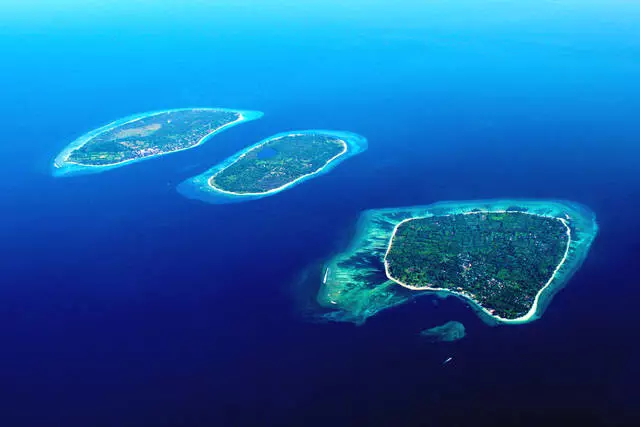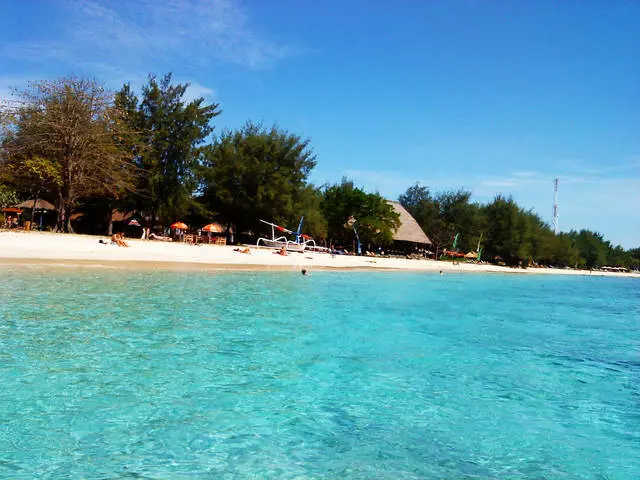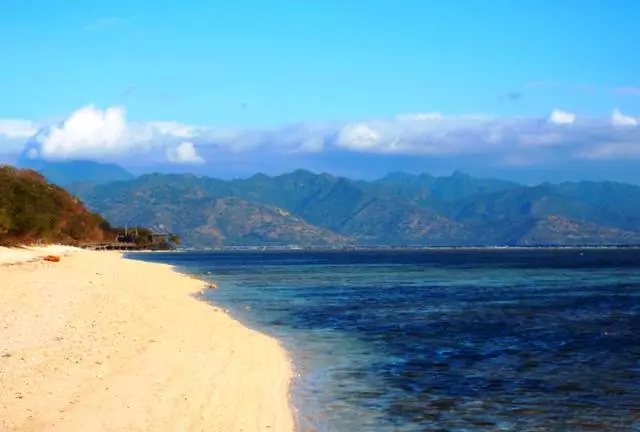Gili Islands (in Indonesian "Tig Gili" or "Kepulauan Gili") are an archipelago of three small islands - Gilie Travangan, Gilieno and Gili-Air Located not far from the northwest coast of the Indonesian Island of Lombok.

These arelands are a popular holiday destination and tourists around the world. On each island there are several resorts, usually consisting of a series of bungalows with a small pool and restaurant. Most locals live on the island of Travangan in the village, stretching along his east side (but not on the coast, and closer to the center). Cars and other motor motion are completely prohibited on the islands, so the preferred method of moving is bicycles and horse crews under the name of the Chidomo. Many prefer to just walk on the island of foot - they are completely tiny! It is possible to get to the islands only on water, at high-speed boats or public boats with Bali or Lombok (there are airports on these islands if that). Prices for travel greatly vary depending on the place of departure and the level of transport comfort. In 2011, the site GiliBookings allows you to buy tickets for speedbots online.

By the way, the name of the archipelago "Gili Island" is incorrect, because "Gili" in essence means "little island" in the language of Sasakov. That is why most of the tiny islands along the coast of Lombok have in their title the word "Gili", so one day the confusion decided to prevent and call other islands only by names. As for Gili-Eir, the word "Air" means in Indonesian not "air", as it would be possible to think, but "water." Gili-Air is named so because it is the only island of three, where there are underground sources of fresh water.

Islands are located in the strait of Lombok. And the famous Islands of Bali is just 35 km to the west of the largest and most western island of the group, Gilie Travganan. And from Bali, and with Lomboka in clear weather you can easily see the archipelago. Because of their close proximity to the equator on the islands reigns a warm, tropical climate with a dry and wet season. In the north of Lomboka is the active stratovancan of Rindjani, on Bali - Volcano Agung: Thus, the island of Gili is perfectly protected from winds, and the climate is dry here more dry compared to the surrounding archipelagoes. Dry season on Gili usually lasts from May to October, and the rainy season is from November to April. Temperatures range between 22 ° C to 34 ° C, with an average annual temperature around 28 ° C. As you can see, the weather here is always almost wonderful, even in rains, which, in fact, not so terrible.
Who lives on the islands? About 450 families live on Guili-Air, in Gili-Meno - 172 families, on Gili-Travanthank - 361 family. Plus a significant number of permanent residents from the West, from Australia and the United States - there is no official statistics on this matter today. But according to approximate estimates, about 3,500 people live on the islands in general. The first settlers of the islands were fishermen - bugs (nationality from southern Sulawesi). In 1971, Lomblek's governor ordered the coconut plantations on the islands and gave the rights to land to private companies. Also, 350 prisoners from the crowded prison Mataram were sent here - they were forced to collect the first harvests in the second half of the 1970s. Many of these prisoners subsequently remained on the islands, becoming permanent residents. The case was not tried with coconuts, and the plantations were abandoned. However, the local population began to raise at home and do business on abandoned lands, which led to a land dispiter that continues at the present time. In the 1980s, tourists learned about the islands - there were times of exponential growth of tourism in the neighboring Bali. The first was mastered by Gili-Air, however, Gilie Travangan soon surpassed it mainly due to the proximity to the best dive places. In the late 1980s and early 1990s, investors rushed to the island, because the potential for development appeared. The first hotel was on Gilie Travangan - he was built in 1982 (ultimately in 2007 it was converted to Pesona Resort with the first Indian restaurant on Gili). Most enterprises and resorts belonging to local residents in the 1980s were repurchased by Western businessmen. In the late 80s, Gilie-Trawanban acquired a reputation as the "Island of Tusovkov" because of the free circulation of drugs - in view of the low population density and the island's remoteness of the police here appeared infrequently. Similar reputation for the island to this day, by the way.

But the same islands are famous for their sporting achievements. Since the 1990s come here to engage Diving - Attracts athletes an abundance of marine life and coral formations. True, already in 2000, a non-profit organization called Eco Gili Trust rushed to protect the coral reefs surrounding the islands - they today, unfortunately, are indeed in a deplorable state due to El Niño (fluctuations in the temperature of the surface layer of the Pacific Ocean) and destructive methods Fisheries (Simply put, fishermen love to throw anchor directly in the stove of corals). Well, from about 2012 on tourism on the islands acquired unprecedented scope and development - great efforts are made to preserve and nature (in particular, the marine park), and at the same time culturally differ from Bali.
Oh yeah, a few words about Gilie-Meno. . The population of the island focused in the center of the island, and the main income brings tourism, coconut plantations and fishing. On the western side of the island there is a small petty lake, where the salt is mined in a dry season. A few years ago on the shelf of the northern part of the island were collected and treated with algae, and on some beaches of the small island, you can see the nests turtle nests. The island attracts much less tourists than Gilie-Travangan, because it is the most quiet and smallest of the group. Nevertheless, the newlyweds are often coming here - swim in crystal clear water and sunbathe on idyllic secluded white sand beaches. On the island there is no fresh water - it is brought from Lombok. There is also no motor movement on Gili-Meno.
